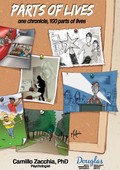In my last post I wrote about stigma by discussing how two similar experiences can be lived in radically different fashions. I used the example of losing a loved one. Because we live our lives through our subjective lenses it is easy to label someone as weak when they handle something less well than us.
As a follow-up to my earlier “Two deaths, two reactions” column, which focussed on depression, I looked at anxiety in my last column. In it, I tell a true story from a number of years ago which illustrates well how radically different our fears can be.
A striking thing about anxiety is that, while we may easily empathize with someone who shares our own fears, most of us fail to understand why people are afraid of things that are meaningless to us.
When I give talks to groups of anxiety sufferers, the room comes alive. People laugh at themselves, nudge each other with their elbows, and nod in agreement. When I give the same talk to students or the general public, reactions are pretty bland. This is because the examples I choose touch some people more than others. If I ask someone to imagine sitting in a dentist’s chair or to eat a piece of bread that fell to the ground, the phobics and obsessives in the audience will cringe or gasp in horror at the thought. The others will think, “What’s the big deal?”
This is why I often ask the question: Would you rather have cancer or the fear of cancer? Almost everyone would prefer the fear of something over the real thing. From the outside, it’s a no-brainer. One is real and one is “just a fear.” But then I ask the follow-up question: But what if you believe you really have cancer? When seen from the inside, a fear is as bad, and sometimes even worse, than the real thing. (See also: The fertile output of the anxious mind.)
The story I relate in my column is self-explanatory. I tell it to show how subjective fears are. This subjectivity contributes to stigma in two ways. First it is difficult to truly empathize with other people’s fears. If someone tells you how terrified they might be of, let’s say, a visit to the dentist, you would have little understanding, especially if you just came from an appointment yourself. This would never happen if a person had a physical condition, would it? If a person is undergoing chemotherapy, we would have no trouble empathizing.
The second consequence is the result of the first. Because it is difficult for other people to understand our personal fears, we tend to hide them. This lack of openness forces many people to suffer in silence.
What’s the big deal with needles?
(Source: Pourquoi avoir peur des piqûres? Journal Métro, February 22, 2011)
It’s funny how subjective our anxieties can be. Many years ago I worked with a woman who was severely agoraphobic. Agoraphobia can be understood as a fear of being away from a safe and secure environment. Most agoraphobics have trouble traveling away from home or being in situations where they feel trapped, such as shopping malls, metros and buses. This woman was unable to be more than a street or two from her home. The thought of taking a bus was unimaginable.
A bus stop…or two
Treatment for agoraphobia involves a number of components. An important one is to gradually face fears in order to regain confidence. During one particular session we discussed the possibility of taking the bus. “How about getting on the bus for a stop or two? You can hop on with a small bag of groceries, wait by the door, and get off when the next stop comes.”
As simple as this step might be to another person, to this woman it was enough to freak her out. I spent half an hour trying to encourage her and reassure her but didn’t get very far. At one point I opened my desk drawer to take out a notepad and she noticed a bag full of syringes I kept there. “What’s up with the needles?” she asked.
“I use them when I work with people who have phobias of needles and injections,” I said.
“What’s the big deal with needles?” was her answer.
Well I suppose they are no big deal to some but I had previously treated a gentleman who was so afraid of needles that he had root canal work done without freezing! True story.
Your fears are not my fears
This is my favourite story about the subjective nature of fears. Here was a woman paralyzed by the thought of getting on a bus, yet unable to understand why someone would have a phobia of needles. I’m sure the needle phobic would gladly have swapped an injection for a bus ride if he could. If a person with an anxiety disorder cannot empathize with another person’s fears, then what can we expect from those without major anxieties?
The subjective nature of our anxieties is what feeds stigma and misunderstanding and what makes many people keep their fears secret. But let’s not kid ourselves, we almost all have our share of anxieties and insecurities. They may differ from person to person but their impact on our lives can be just as strong. We don’t have to have the same fears to understand fear.
Tagged as agoraphobia, Anxiety, fear, phobias, stigma.
Posted in Anxiety.
Posted on 02 Mar 2011
